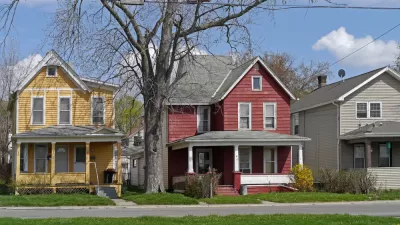Social / Demographics
Bloomberg's Legacy: Freedom-Hating Nanny or Public Health Visionary?
To his critics, Mayor Bloomberg's initiatives aimed at decreasing smoking, increasing active lifestyles, and tackling obesity add up to the creation of a "Nanny State". A new article challenges the critics by framing him as a public health pioneer.
Low Crime Rates In Large Cities Support Multi-Modal Planning and Smart Growth
Contrary to popular assumptions, large, transit-oriented cities have lower crime rates than smaller, automobile-oriented cities. Jane Jacobs was right! This column discusses this phenomenon and its implications for transport and land use planning.
Is Your Commute Killing You?
Though research has been piling up on the adverse health impacts connected with driving long distances every day, it turns out that no matter how you travel to work, "having a job far from home can undermine health."
Neighborhoods Matter
Against a backdrop of increasing spatial segregation of incomes, Robert J. Sampson looks at how neighborhood inequality influences multiple aspects of everyday life. How we address such inequality indicates what kind of society we want to be.
A Reason to Celebrate More Driving
On these pages we usually tout the developed world's decline in driving and car ownership. But in Saudi Arabia, where women are not allowed to drive, the automobile serves as a vehicle for improving human rights.
Is Downtown Denver Too Popular?
Some of Denver's leaders are sounding the alarm over rising household income levels and the threat to affordable housing. But in an editorial in The Denver Post, Vincent Carroll argues that an exclusive downtown Denver is better than the alternative.
How Cities Can Help Get the Kids to Daycare
Erin Anderssen takes a critical look at the role of our cities in the provision of much needed childcare. While municipally-delivered childcare has been successful in Scandinavia, some Canadian cities are left playing with alternative approaches.
Making Sure Bike Lanes Aren't Viewed as "White Lanes"
Bike infrastructure is often viewed with skepticism in minority neighborhoods across the U.S. Jay Walljasper looks at how to extend the benefits of biking to communities that often have fewer options for transportation and exercise.
New Study Ties Distracted Driving to Increase in Pedestrian and Cyclist Deaths
Though vehicular deaths have been declining across the U.S., pedestrian and cyclist deaths have risen. While intuition might say our ubiquitous cell phones are to blame, hard data has been scarce. A new study seems to support this conclusion.
Mapping America's Many Moods
Are you exceedingly agreeable or exceptionally conscientious? If so, there's a good chance you live in Utah or South Carolina. At least that's according to the findings of a 13-year study into American attitudes conducted by a team of researchers.

Millennial Invasion Creates a "New Washington"
Drawn by plentiful jobs and an improving quality of life, millennials helped swell D.C.'s population over the last decade - to the delight of some and dismay of others. In a series of articles, The Post chronicles the city's "millennials moment".

The Decline and Disappearance of the Middle Class Neighborhood
A new study observes the growing economic and income divide’s impact on America’s neighborhoods. Researchers have found the proportion of Americans living in 'middle class' neighborhoods declining, while 'rich' and 'poor' neighborhoods are growing.
The Gold Standard for Civic Data Delivery
Emily Badger is extremely impressed—and for good reason—with the City of Los Angeles' new neighborhood data portal, built in connection with the development a new health and wellness chapter for the city's General Plan.
Air Pollution Identified as a Leading Cause of Cancer Deaths
For the first time, the World Health Organization has identified air pollution, in its entirety, as a cause of cancer, putting it on par with tobacco smoke, asbestos and arsenic. In 2010, 223,000 people died from lung cancer caused by air pollution.
Gov. Brown Draws on his Mayoral Experience to Veto Affordable Housing Bill
Calif. Gov. Jerry Brown served two terms as mayor of Oakland. His attempts to bring more downtown housing to the city led him to veto an inclusionary housing bill that would have required developers to supply affordable housing or pay an in-lieu fee.
Does Evolution Explain the Popularity of Frank Gehry's Designs?
Apparently there may be a subconscious reason why so many people are attracted to the architecture of Frank Gehry. Using magnetic resonance imaging, researchers have found that our brains are hard-wired to enjoy curvilinear forms.
Design Matters
Creating parks that benefit and reflect the needs of the communities that use them is the goal for both planners and landscape architects. Programming is a big part of this. So is design.
Reading Between the Crosswalk: On the Significance of Pedestrian Icons
Have you ever noticed that the image of little man (it's usually a man) in pedestrian traffic icons differs depending on which country you're in? Artist Maya Barkai has, and her new project seeks to explore what these guys say about their culture.
A Sociologist Explains Why We Shouldn't Dismiss the Cul-de-Sac
With their anti-urban inward orientation, cul-de-sacs are representative of the auto-oriented, privatized suburban development model. But one sociologist is out to demonstrate their benefits by showing how cul-de-sacs can develop social cohesion.
The Inputs Change, But Our Desire to Rank Places Never Wanes
Add a list of the "Top 100 Best Places to Live" to the seemingly endless series of rankings seeking to quantify what's best and worst about our cities and states. Though the inputs have changed over the last 80 years, our desire to rank hasn't.
Pagination
Urban Design for Planners 1: Software Tools
This six-course series explores essential urban design concepts using open source software and equips planners with the tools they need to participate fully in the urban design process.
Planning for Universal Design
Learn the tools for implementing Universal Design in planning regulations.
Heyer Gruel & Associates PA
JM Goldson LLC
Custer County Colorado
City of Camden Redevelopment Agency
City of Astoria
Transportation Research & Education Center (TREC) at Portland State University
Jefferson Parish Government
Camden Redevelopment Agency
City of Claremont


































